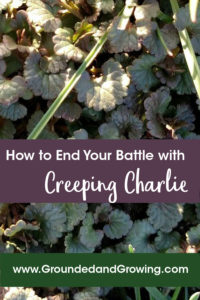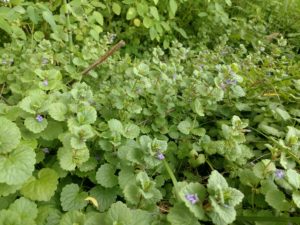 Tackling Creeping Charlie can frustrate even the most seasoned gardener. For some people, like my dad, declaring victory becomes downright personal.
Tackling Creeping Charlie can frustrate even the most seasoned gardener. For some people, like my dad, declaring victory becomes downright personal.
This post contains affiliate links.
For as long as I can remember, my dad has relentlessly battled creeping Charlie (a.k.a. ground ivy). It’s amazing I didn’t grow up to hate gardening despite how many hours I spent pulling every bit of this plant that I could grasp, trying to subdue the tireless march of green across our yard. Nothing he tried over the years seemed to be more than a temporary fix. This defeat just fueled his hatred.
I can recall entire phone conversations after I was an adult living in central Illinois centered around his current plan of attack against creeping Charlie. No matter what I suggested he try, it fell on deaf ears (I just might know something about plants, but that’s a topic for another article. I guess I’m always his little girl). Every year, he focused on eliminating this plant from his slice of the universe once and for all. It conjured up images of the movie Caddyshack where Bill Murray blows up the golf course in pursuit of the gopher. But in this case, it’s my dad, Bill attacking creeping Charlie.
As with many of the most detested weeds, settlers brought creeping Charlie here on purpose, with nothing but the best of intentions.
European settlers are the guilty party people believed responsible for spreading creeping Charlie, more formally known as Glechoma hederacea, worldwide.
Creeping Charlie is a native plant in Europe and Southwest Asia and historically was used in traditional medicines, and as a food crop for thousands of years. As a medicine, it was used to treat everything from congestion to indigestion, kidney disease, and as a general anti-inflammatory agent. As food, people drank it steeped as a tea rich in Vitamin C, and ate it as a cooked green, or as a salad green.
Before hops were used to flavor beer, brewers used creeping Charlie!
Despite its long medicinal and culinary history, modern chemistry has isolated several compounds within creeping Charlie that are toxic to the liver, gastrointestinal tract, and kidneys. Armed with that knowledge, I would suggest you avoid consuming it!
This extensive history of creeping Charlie and its medicinal and culinary applications is the main reason Europeans brought it with them as they settled in all corners of the world. They also grew the plant as an ornamental ground cover and a potted plant. If you can set your dislike of the plant aside for a moment, it really does have attractive fan-shaped leaves with toothed edges and striking blue-violet flowers in the spring. Its flowers also reportedly support some pollinator insects, so that’s another redeeming quality.
Close inspection of a creeping Charlie plant reveals a big reason it is so aggressive in yards and gardens.
It has square-shaped stems, making it a member of the mint family. Mint is a big bully in the backyard. It can find its way over, under, around and even through some barriers designed to contain it.
Combine this aggressive nature with creeping Charlie’s preferred location containing heavy, rich soil with high fertility and moisture, and it’s the perfect storm for your garden. It also loves to grow in shady areas where grass grows poorly. So it’s no surprise my dad has the worst problems with creeping Charlie on the edge of the vegetable garden where the soil is super rich, fertile and watered, and in a shady, moist corner of his yard where grass never grows well.
Creeping Charlie has every trait you wish a weed didn’t have.
It’s a perennial plant. You can pull it, but any little bit left behind will just grow into a new plant. Various weed killers may or may not be effective; different sources have recorded creeping Charlie’s susceptibility and resistance to the same chemicals.
A friend of mine studied herbicides to control creeping Charlie as his Ph.D. project! That alone should tell you this is one tough plant. He said creeping Charlie does not allow most herbicides to be distributed throughout the plant, resulting in partial dieback, but never complete elimination of the plant.
The most effective recommendations for chemical control suggest using a combination of herbicides rather than just one. One popular combination is 2,4-D, dicamba, and MCPP. Another is 2,4-D and triclopyr. The idea is that by attacking the plant with different chemicals that kill via different modes of action, this lessens the chances of a plant developing resistance to the chemicals. The likelihood of a plant population developing resistance to one chemical is a lot greater than a population developing resistance to three different chemicals that attack in three different ways.
If traditional herbicides worry you, there are several effective non-synthetic options that use iron toxicity to kill weeds. Broadleaf weeds and lawn grasses are both plants, but they have some fundamental differences in their physiology. Broadleaf weeds take up iron very quickly, much quicker than grasses. They take it up so quickly, they poison themselves. Grasses don’t absorb the iron fast enough to cause harm.
Fall is reportedly the best time to apply herbicide to creeping Charlie.
This is probably because plants naturally transport materials to the roots in preparation for winter. The second best time for herbicide application is spring when creeping Charlie is actively growing and flowering. Again, this is when the plant is naturally transporting a lot of materials through its system. Applying herbicides at either of these times makes it more likely that the chemicals will get distributed throughout the plant, increasing their effectiveness.
In just about any discussion of controlling creeping Charlie, someone mentions using borax. Like most home remedies, while it has its basis in truth, I don’t recommend people try it. Creeping Charlie prefers soil with low boron levels; too much boron will kill it. Borax contains boron, so if you apply a solution of borax to the soil, you can raise the level of boron in the soil enough to kill the creeping Charlie.
Seems simple, right?
The “minor detail” is that there is a fine line between enough boron to control creeping Charlie and enough boron to kill every other plant around it as well.
Plus, Boron doesn’t break down or otherwise “go away” after its applied. So there is a good chance that in your zeal to finally kill creeping Charlie once and for all you will also kill every other plant near it, potentially for years.
Two other control methods to consider are using a dethatching rake or if you’re really desperate, killing off an area and starting over. After decades of attempts and hundreds, maybe even thousands of dollars in herbicides, my dad used a dethatching rake over the course of an entire summer to finally declare victory over the creeping Charlie. Most of the spots needed reseeding with grass as he removed the creeping Charlie. Overall this process worked very well, but it was incredibly time and labor intensive.
Some people wave the white flag and use non-selective herbicides like glyphosate (Roundup) or black plastic to kill off areas overrun with creeping Charlie. Placing black plastic over an infested area will heat up the soil and kill all plants and seeds present, but it takes time. I’ve read time estimates ranging from weeks to three months or more.
I hope I’m not jinxing myself in writing this, but so far we haven’t seen creeping Charlie in our yard. If it ever does make an appearance, especially if it’s where grass refuses to grow, I’ll probably just leave it alone and be thankful. I’ve dealt enough with creeping Charlie to last my lifetime!
Creeping Charlie Arsenal Control Options
Herbicides– apply according to label directions; repeat applications may be necessary.
- 2,4-D, Dicamba, and MCPP
- 2,4-D and Triclopyr
- Glyphosate— A non-selective herbicide (which means it kills everything in it’s path); keep an eye on the various formulas available. Some have additives that increase the residual effects. This means you may not be able to plant anything where you use it for week, months, or even a year. This may be good or bad depending on your goals!
- Iron Chelates— There are several brands available with chelated iron listed as the active ingredient (usually as Iron HEDTA or FeHEDTA). They reportedly have less health and environmental effects than traditional synthetic herbicides. Plus they’re effective against tough weeds like creeping Charlie.
Physical Destruction
- Dethatching Rake— This link shows the style of rake my dad used to rid his yard of creeping Charlie. It’s straight up, old-school brute force labor. He worked on a small section at a time and reseeded the resulting bare sections with grass seed along the way.
- Black Plastic Tarp— There are tons of options available for purchasing black plastic for the garden (see link). Basically you cover up the section of yard invaded by creeping Charlie with the black plastic, anchor it to keep it in place. Then sit back and let the summer sun cook the creeping Charlie (and everything else under the plastic) to death. In my opinion this would be one of my last-ditch options. Not because it doesn’t work, but because you have to leave it in place for weeks to months at a time for it to work well.
**Update**

Arrgh! I found my first thriving patch of creeping Charlie in my yard in 2018.
I think I did jinx myself by writing this post. This spring (2018) while cleaning up down by the big retention pond in our backyard, I spotted it. We have a lot of henbit, but as I got closer I knew it was my old buddy Charlie. It’s in an area right along the bank of the pond. It can grow there all it wants. If it starts spreading into my actual yard, maybe I’ll worry. Maybe.
If you liked this post, please subscribe to Grounded and Growing today and receive your copy of “15 Tips to Become a '15 Minute Gardener'” so you can spend less time working ON your garden and more time enjoying being IN your garden.! It’s absolutely free. When you join the Grounded and Growing community, you’ll finally take the garden off your “To-Do” list and allow yourself time to enjoy your garden and savor the peace and serenity there. I tell subscribers about new posts as soon as I hit ‘publish’ and send weekly-ish updates on what’s going on in my garden– good, bad AND ugly.

All Rights Reserved. © 2019 Jennifer Schultz Nelson.
[…] (Glechoma hederacea) & Henbit (Lamium amplexicaule)— You may have read my post about creeping Charlie being my dad’s most hated weed. A weed commonly confused with creeping Charlie is henbit, a […]